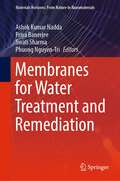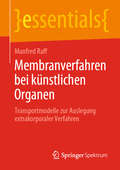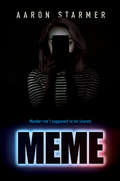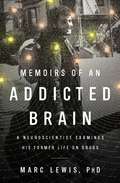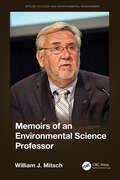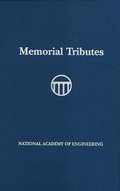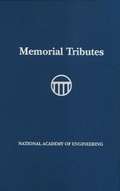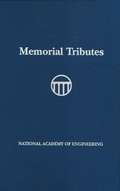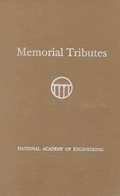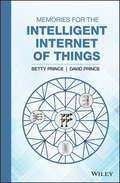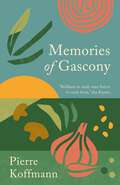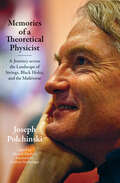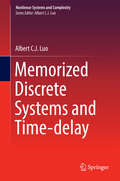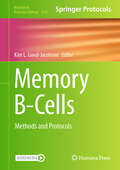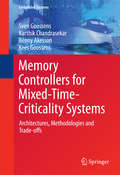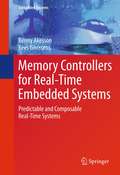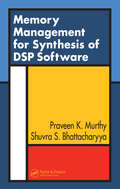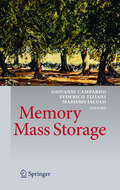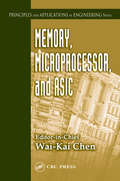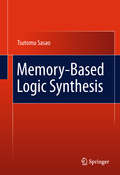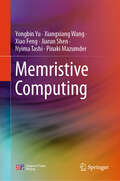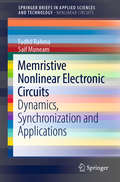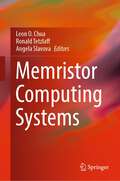- Table View
- List View
Membranes for Water Treatment and Remediation (Materials Horizons: From Nature to Nanomaterials)
by Swati Sharma Ashok Kumar Nadda Priya Banerjee Phuong Nguyen-TriThis book provides comprehensive description of polymeric membranes in water treatment and remediation. It describes both the sustainability challenges and new opportunities to use membranes for water decontamination. It also discusses the environmental-related issues, challenges and advantages of using membrane-based systems and provides comprehensive description of various polymeric membranes, nanomaterials, biomolecules and their integrated systems for wastewater treatment. Various topics covered in this book are direct pressure-driven and osmotic-driven membrane processes, hybrid membrane processes (such as membrane bioreactors and integrating membrane separation with other processes), and resource recovery-oriented membrane-based processes. The book will be useful for students, researchers and professionals working in the area of materials science and environmental chemistry.
Membranverfahren bei künstlichen Organen: Transportmodelle zur Auslegung extrakorporaler Verfahren (essentials)
by Manfred RaffKünstliche Organe sind Membranmodule, welche in einem extrakorporalen Kreislauf Blutinhaltsstoffe austauschen bzw. entfernen. Dabei kommen die klassischen Prinzipien der Crossflow- und der Gegenstromverfahren zur Anwendung. Manfred Raff zeigt, wie für die Auslegung derartiger Membranverfahren aus Modellen am differentiellen Membranelement funktionale Zusammenhänge von Zielgrößen und geometrischen, stofflichen und Betriebsparametern für das gesamte Modul abgeleitet werden. Die Ergebnisgleichungen können auch für technische Anwendungen eingesetzt werden. Der Autor:Manfred Raff hat sich in seinem Berufsleben mit dem wissenschaftlichen Schwerpunkt Membrantechnologie beschäftigt. Er war zunächst in der Industrie in der Forschung, Entwicklung und Produktion von Membranen und Modulen tätig. Später hat er als Hochschullehrer an der Hochschule Furtwangen Verfahrenstechnik gelehrt und Membranthemen, wie Messung der Porengrößenverteilung in Membranen, Untersuchung des Stofftransports in der künstlichen Leber, Simulation des Stofftransports bei der Highflux-Dialyse, erforscht. Nach der Pensionierung arbeitet er weiterhin als Lehrbeauftragter an der HFU, Campus Schwenningen.
Meme
by Aaron StarmerA tense, psychological thriller for the internet age about the destructive combination of self-important goals and self-serving plans.Cole Weston—former friend, former boyfriend—has become dangerous, erratic. Something needs to be done. Getting rid of Cole is practically a public service. So high school seniors Holly Morse, Grayson Hobbs, Logan Bailey, and Meeka Miller devise a plan. Kill Cole. Bury him in the woods behind Meeka&’s house. Bury him deep, deep in the ground along with four old cell phones, wiped except for their video confession as insurance that no one will ever betray the group. Everything is perfect, until the meme appears. It&’s a screenshot from their confession… a confession that&’s supposed to be entombed with Cole forever in the cold Vermont dirt.
Memoirs of an Addicted Brain: A Neuroscientist Examines his Former Life on Drugs
by Marc LewisMarc Lewis’s relationship with drugs began in a New England boarding school where, as a bullied and homesick fifteen-year-old, he made brief escapes from reality by way of cough medicine, alcohol, and marijuana. In Berkeley, California, in its hippie heyday, he found methamphetamine and LSD and heroin. He sniffed nitrous oxide in Malaysia and frequented Calcutta’s opium dens. Ultimately, though, his journey took him where it takes most addicts: into a life of addiction, desperation, deception, and crime. But unlike most addicts, Lewis recovered and became a developmental psychologist and researcher in neuroscience. In Memoirs of an Addicted Brain, he applies his professional expertise to a study of his former self, using the story of his own journey through addiction to tell the universal story of addictions of every kind. He explains the neurological effects of a variety of powerful drugs, and shows how they speak to the brain-itself designed to seek rewards and soothe pain-in its own language. And he illuminates how craving overtakes the nervous system, sculpting a synaptic network dedicated to one goal-more-at the expense of everything else.
Memoirs of an Environmental Science Professor: A Memoir (Applied Ecology and Environmental Management)
by William MitschThis book shows, through real and current examples from the field of environmental and wetland science, that personal and professional success depends on persistence and a refusal to compromise on "doing the right thing" which for Professor Mitsch meant saving some of the world’s most important ecosystems, as well as educating future researchers and the general public along the way. Case studies described in this book illustrate that persistence pays off especially when the cause is motivated by something as important as improving our natural environment. They explain clearly that success is not easy, disasters and failures are part of the process, but having goals result in meaningful steps toward it. Features Emphasizes how it is possible to develop long-term goals and persistence for success both in the academic and environmental world. Offers examples set in universities across America and highlights important national wetlands such as the Florida Everglades, the Kankakee River Marshlands in the Great Lakes region, and Ohio’s Olentangy River Wetland Park, a Ramsar Wetland of International Importance. Speaks to scientists from across the country and the world. Discusses chronologically the developments and the achievements of environmental /wetland fields on a global scale. Explains how his personal achievements contributed to the growth of wetland and environmental sciences. Students and professionals in the physical and biological sciences, including chemistry, environmental science, ecological fields, and environmental policy, and especially environmental consultants such as scientists, managers, and engineers, will feel a sense of camaraderie with Professor Mitsch. His longstanding career and devotion to environmental and wetland sciences are an inspiration to all who currently work in the field, aspire to, or simply harbor a sense of appreciation about the natural world and want to learn more about steps that can be taken to manage and protect our planet and the environment.
Memorial Tributes
by The National Academy of SciencesThis is the fifteenth volume in the series of Memorial Tributes compiled by the National Academy of Engineering as a personal remembrance of the lives and outstanding achievements of its members and foreign associates. These volumes are intended to stand as an enduring record of the many contributions of engineers and engineering to the benefit of humankind. In most cases, the authors of the tributes are contemporaries or colleagues who had personal knowledge of the interests and the engineering accomplishments of the deceased.
Memorial Tributes: Volume 14
by National Academy of EngineeringThis is the fourteenth volume in the series of Memorial Tributes compiled by the National Academy of Engineering as a personal remembrance of the lives and outstanding achievements of its members and foreign associates. These volumes are intended to stand as an enduring record of the many contributions of engineers and engineering to the benefit of humankind. In most cases, the authors of the tributes are contemporaries or colleagues who had personal knowledge of the interests and the engineering accomplishments of the deceased.
Memorial Tributes: Volume 20
by National Academy of EngineeringThis is the 20th Volume in the series Memorial Tributes compiled by the National Academy of Engineering as a personal remembrance of the lives and outstanding achievements of its members and foreign associates. These volumes are intended to stand as an enduring record of the many contributions of engineers and engineering to the benefit of humankind. In most cases, the authors of the tributes are contemporaries or colleagues who had personal knowledge of the interests and the engineering accomplishments of the deceased. Through its members and foreign associates, the Academy carries out the responsibilities for which it was established in 1964. Under the charter of the National Academy of Sciences, the National Academy of Engineering was formed as a parallel organization of outstanding engineers. Members are elected on the basis of significant contributions to engineering theory and practice and to the literature of engineering or on the basis of demonstrated unusual accomplishments in the pioneering of new and developing fields of technology. The National Academies share a responsibility to advise the federal government on matters of science and technology. The expertise and credibility that the National Academy of Engineering brings to that task stem directly from the abilities, interests, and achievements of our members and foreign associates, our colleagues and friends, whose special gifts we remember in this book.
Memorial Tributes: Volume 8
by National Academy of Engineering StaffThis series presents biographies of deceased members of the National Academy of Engineering.
Memories for the Intelligent Internet of Things
by Betty Prince David PrinceA detailed, practical review of state-of-the-art implementations of memory in IoT hardware As the Internet of Things (IoT) technology continues to evolve and become increasingly common across an array of specialized and consumer product applications, the demand on engineers to design new generations of flexible, low-cost, low power embedded memories into IoT hardware becomes ever greater. This book helps them meet that demand. Coauthored by a leading international expert and multiple patent holder, this book gets engineers up to speed on state-of-the-art implementations of memory in IoT hardware. Memories for the Intelligent Internet of Things covers an array of common and cutting-edge IoT embedded memory implementations. Ultra-low-power memories for IoT devices-including plastic and polymer circuitry for specialized applications, such as medical electronics-are described. The authors explore microcontrollers with embedded memory used for smart control of a multitude of Internet devices. They also consider neuromorphic memories made in Ferroelectric RAM (FeRAM), Resistance RAM (ReRAM), and Magnetic RAM (MRAM) technologies to implement artificial intelligence (AI) for the collection, processing, and presentation of large quantities of data generated by IoT hardware. Throughout the focus is on memory technologies which are complementary metal oxide semiconductor (CMOS) compatible, including embedded floating gate and charge trapping EEPROM/Flash along with FeRAMS, FeFETs, MRAMs and ReRAMs. Provides a timely, highly practical look at state-of-the-art IoT memory implementations for an array of product applications Synthesizes basic science with original analysis of memory technologies for Internet of Things (IoT) based on the authors' extensive experience in the field Focuses on practical and timely applications throughout Features numerous illustrations, tables, application requirements, and photographs Considers memory related security issues in IoT devices Memories for the Intelligent Internet of Things is a valuable working resource for electrical engineers and engineering managers working in the electronics system and semiconductor industries. It is also an indispensable reference/text for graduate and advanced undergraduate students interested in the latest developments in integrated circuit devices and systems.
Memories of Gascony
by Pierre KoffmannPierre Koffmann's Memories of Gascony is the story of how one of the most influential chefs of our time first learned to love food.With recipes and reminiscences from his grandparents' home in rural Gascony, this is an intimate account of school holidays spent on the farm helping his grandfather to harvest and hunt, and learning to treasure seasonality, simplicity and the best ingredients at his grandmother's side.The finest of Gascony produce is here, with a focus on simplicity. The recipes stand the test of time and speak to the food tastes and trends of today. While you read the charming stories of everyday life on the farm, you'll devour the cuisine as you go along - dandelion salad with bacon and poached egg, grilled chicken with shallots and vinaigrette, and greengages in Armagnac in Spring; chicken liver pate with capers, Bayonne ham tart with garlic, oeufs a la neige in Summer; roast hare with mustard and beetroot, salt cod cassoulet and quince jelly in Autumn; and fried eggs with foie gras, potato and bacon pie and tarte aux pruneaux in Winter.This is a book to learn, love and live from."One of the great works on regional French food, by one of the greatest of all French chefs." Tom Parker Bowles"Pierre Koffmann is a giant of the kitchen, and his shadow looms larger than anyone else's. Almost every decent chef I can think of learned most of what he knows from Pierre." Giles Coren"If you do not own a copy of Pierre Koffmann's glorious Memories of Gascony your cookbook collection is not complete. Brilliant to read; even better to cook from." Jay Rayner"No words can describe how delicious his food is. He is the Chef's Chef." Michel Roux Jr
Memories of Gascony
by Pierre KoffmannPierre Koffmann's Memories of Gascony is the story of how one of the most influential chefs of our time first learned to love food.With recipes and reminiscences from his grandparents' home in rural Gascony, this is an intimate account of school holidays spent on the farm helping his grandfather to harvest and hunt, and learning to treasure seasonality, simplicity and the best ingredients at his grandmother's side.The finest of Gascony produce is here, with a focus on simplicity. The recipes stand the test of time and speak to the food tastes and trends of today. While you read the charming stories of everyday life on the farm, you'll devour the cuisine as you go along - dandelion salad with bacon and poached egg, grilled chicken with shallots and vinaigrette, and greengages in Armagnac in Spring; chicken liver pate with capers, Bayonne ham tart with garlic, oeufs a la neige in Summer; roast hare with mustard and beetroot, salt cod cassoulet and quince jelly in Autumn; and fried eggs with foie gras, potato and bacon pie and tarte aux pruneaux in Winter.This is a book to learn, love and live from."One of the great works on regional French food, by one of the greatest of all French chefs." Tom Parker Bowles"Pierre Koffmann is a giant of the kitchen, and his shadow looms larger than anyone else's. Almost every decent chef I can think of learned most of what he knows from Pierre." Giles Coren"If you do not own a copy of Pierre Koffmann's glorious Memories of Gascony your cookbook collection is not complete. Brilliant to read; even better to cook from." Jay Rayner"No words can describe how delicious his food is. He is the Chef's Chef." Michel Roux Jr
Memories of a Theoretical Physicist: A Journey across the Landscape of Strings, Black Holes, and the Multiverse
by Joseph PolchinskiA groundbreaking theoretical physicist traces his career, reflecting on the successes and failures, triumphs and insecurities of a life cut short by cancer.The groundbreaking theoretical physicist Joseph Polchinski explained the genesis of his memoir this way: &“Having only two bodies of knowledge, myself and physics, I decided to write an autobiography about my development as a theoretical physicist.&” In this posthumously published account of his life and work, Polchinski (1954–2018) describes successes and failures, triumphs and insecurities, and the sheer persistence that led to his greatest discoveries. Writing engagingly and accessibly, with the wry humor for which he was known, Polchinski gives theoretical physics a very human face. Polchinski, famous for his contributions to string theory, may have changed the course of modern theoretical physics, but he was a late bloomer—doing most of his important work after the age of forty. His death from brain cancer at sixty-three cut short a career at its peak. Working on the memoir after his diagnosis, using a text-to-speech algorithm because he could no longer read words on a page, he was able to recapitulate his entire career, down to the details of problems he had worked on. For Polchinski, physics went deeper than words. This edition includes photographs from Polchinski&’s professional and family life, as well as physics explainer boxes, other technical edits, and bibliographic notes by his former student Ahmad Almheiri, a foreword by Andrew Strominger, and an afterword by his wife Dorothy Chun and sons Steven and Daniel.
Memorized Discrete Systems and Time-delay
by Albert C. J. LuoThis book examines discrete dynamical systems with memory--nonlinear systems that exist extensively in biological organisms and financial and economic organizations, and time-delay systems that can be discretized into the memorized, discrete dynamical systems. It book further discusses stability and bifurcations of time-delay dynamical systems that can be investigated through memorized dynamical systems as well as bifurcations of memorized nonlinear dynamical systems, discretization methods of time-delay systems, and periodic motions to chaos in nonlinear time-delay systems. The book helps readers find analytical solutions of MDS, change traditional perturbation analysis in time-delay systems, detect motion complexity and singularity in MDS; and determine stability, bifurcation, and chaos in any time-delay system.
Memory B-Cells: Methods and Protocols (Methods in Molecular Biology #2826)
by Kim L. Good-JacobsonThis volume details in methods to assess memory B cell formation and function in mice and humans. Chapters guide readers through tetramer-based methods to assess antigen-specific memory B cell dynamics in humans and mice in different vaccine, next-generation deep-sequencing, single-cell techniques to assess epigenomic, VDJ landscapes, lymph node aspirates from humans, advanced imaging, murine models to determine memory B cells formation, and bioinformatic techniques and in silico modelling of memory b cell formation. Written in the highly successful Methods in Molecular Biology series format, chapters include introductions to their respective topics, lists of the necessary materials and reagents, step-by-step, readily reproducible laboratory protocols, and key tips on troubleshooting and avoiding known pitfalls. Authoritative and cutting-edge, Memory B-Cells: Methods and Protocols aims to ensure successful results in the further study of this vital field.
Memory Controllers for Mixed-Time-Criticality Systems
by Kees Goossens Benny Akesson Sven Goossens Karthik ChandrasekarThis book discusses the design and performance analysis of SDRAM controllers that cater to both real-time and best-effort applications, i. e. mixed-time-criticality memory controllers. The authors describe the state of the art, and then focus on an architecture template for reconfigurable memory controllers that addresses effectively the quickly evolving set of SDRAM standards, in terms of worst-case timing and power analysis, as well as implementation. A prototype implementation of the controller in SystemC and synthesizable VHDL for an FPGA development board are used as a proof of concept of the architecture template.
Memory Controllers for Real-Time Embedded Systems
by Kees Goossens Benny AkessonVerification of real-time requirements in systems-on-chip becomes more complex as more applications are integrated. Predictable and composable systems can manage the increasing complexity using formal verification and simulation. This book explains the concepts of predictability and composability and shows how to apply them to the design and analysis of a memory controller, which is a key component in any real-time system.
Memory Management for Synthesis of DSP Software
by Shuvra S. Bhattacharyya Praveen K. MurthyAlthough programming in memory-restricted environments is never easy, this holds especially true for digital signal processing (DSP). The data-rich, computation-intensive nature of DSP makes memory management a chief and challenging concern for designers. Memory Management for Synthesis of DSP Software focuses on minimizing memory requirements during the synthesis of DSP software from dataflow representations. Dataflow representations are used in many popular DSP design tools, and the methods of this book can be applied in that context, as well as other contexts where dataflow is used.This book systematically reviews research conducted by the authors on memory minimization techniques for compiling synchronous dataflow (SDF) specifications. Beginning with an overview of the foundations of software synthesis techniques from SDF descriptions, it examines aggressive buffer-sharing techniques that take advantage of specific and quantifiable tradeoffs between code size and buffer size to achieve high levels of buffer memory optimization.The authors outline coarse-level strategies using lifetime analysis and dynamic storage allocation (DSA) for efficient buffer sharing as one approach and demonstrate the role of the CBP (consumed-before-produced) parameter at a finer level using a merging framework for buffer sharing. They present two powerful algorithms for combining these sharing techniques and then introduce techniques that are not restricted to the single appearance scheduling space of the other techniques.Extensively illustrated to clarify the mathematical concepts, Memory Management for Synthesis of DSP Software presents a comprehensive survey of state-of-the-art research in DSP software synthesis.
Memory Mass Storage
by Federico Tiziani Giovanni Campardo Massimo IaculoMemory Mass Storage describes the fundamental storage technologies, like Semiconductor, Magnetic, Optical and Uncommon, detailing the main technical characteristics of the storage devices. It deals not only with semiconductor and hard disk memory, but also with different ways to manufacture and assembly them, and with their application to meet market requirements. It also provides an introduction to the epistemological issues arising in defining the process of remembering, as well as an overview on human memory, and an interesting excursus about biological memories and their organization, to better understand how the best memory we have, our brain, is able to imagine and design memory.
Memory, Microprocessor, and ASIC (Principles And Applications In Engineering Ser. #Vol. 7)
by Wai-Kai ChenTiming, memory, power dissipation, testing, and testability are all crucial elements of VLSI circuit design. In this volume culled from the popular VLSI Handbook, experts from around the world provide in-depth discussions on these and related topics. Stacked gate, embedded, and flash memory all receive detailed treatment, including their power cons
Memory-Based Logic Synthesis
by Tsutomu SasaoThis book describes the synthesis of logic functions using memories. It is useful to design field programmable gate arrays (FPGAs) that contain both small-scale memories, called look-up tables (LUTs), and medium-scale memories, called embedded memories. This is a valuable reference for both FPGA system designers and CAD tool developers, concerned with logic synthesis for FPGAs.
Memristive Computing
by Pinaki Mazumder Xiao Feng Yongbin Yu Xiangxiang Wang Jiarun Shen Nyima TashiThis book delves into a wide array of topics, ranging from memristor and its emulator to chaotic circuits based on memristor, memristor-based en/decryption systems, filter design based on memristive family, memristive filter for signal processing, memristor network-based swarm intelligence, dynamic analysis of memristive neural networks, and the application of memristor-based neural networks. It provides a comprehensive and systematic exploration of how memristors empower and drive cutting-edge research in neuromorphic computing and artificial intelligence. This book encourages fostering interdisciplinary information literacy and cultivating cross-disciplinary computational thinking. This book plays a pivotal role in embracing and advancing the development of neuromorphic computing. Through profound foundational theories and academic analysis methods, this book guides artificial intelligence graduate students and engineering professionals in constructing a comprehensive knowledge and technological framework for memristor research.
Memristive Nonlinear Electronic Circuits: Dynamics, Synchronization and Applications (SpringerBriefs in Applied Sciences and Technology)
by Fadhil Rahma Saif MuneamMemristive Nonlinear Electronic Circuits deals with nonlinear systems in the design and implementation of circuits for generating complex dynamics. The brief proposes a new memristor model using an inverse tangent function, which achieves the characteristics of the memristor and can be implemented easily because it corresponds to the bipolar transistor differential pair. The authors design a new model-based memristive time-delay system by obtaining a time-delay memristive differential equation, which can generate an n-scroll chaotic attractor by adjusting the proposed nonlinear function. These designs are carried out using OrCAD-PSpice. The brief also presents a new time-delay memristive circuit excited by a nonautonomous staircase function which can generate grid chaotic attractors: new families of grids of n×m-scrolls. For increasingly complex dynamics of the circuits, the authors propose a new five-dimensional autonomous system with two memristors. The dynamical characteristics are investigated by phase portraits and bifurcation diagrams. The brief applies two synchronization methods to the memristive circuits: PC synchronization, and feedback control synchronization. The authors consider synchronization as the idea underlying idea the applications in nonlinear electronic circuits. Finally, the double-memristor system is employed to give rise to a highly secure dual-stage encryption technique.
Memristor Computing Systems
by Ronald Tetzlaff Leon O. Chua Angela SlavovaThis contributed volume offers practical solutions and design-, modeling-, and implementation-related insights that address current research problems in memristors, memristive devices, and memristor computing. The book studies and addresses related challenges in and proposes solutions for the future of memristor computing. State-of-the-art research on memristor modeling, memristive interconnections, memory circuit architectures, software simulation tools, and applications of memristors in computing are presented. Utilising contributions from numerous experts in the field, written in clear language and illustrated throughout, this book is a comprehensive reference work. Memristor Computing Systems explains memristors and memristive devices in an accessible way for graduate students and researchers with a basic knowledge of electrical and control systems engineering, as well as prompting further research for more experienced academics.
